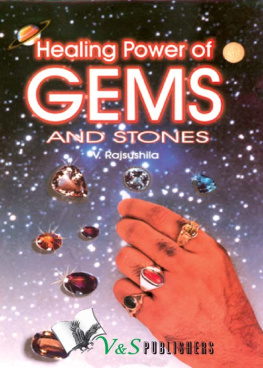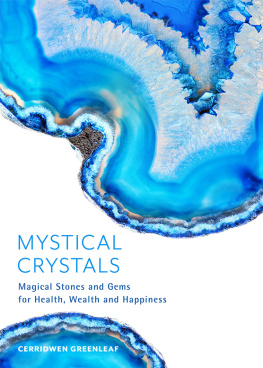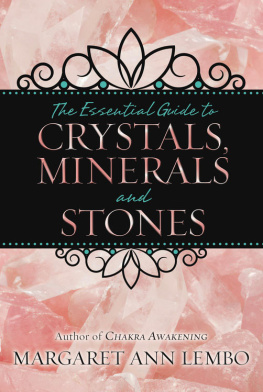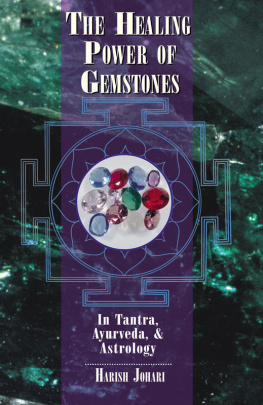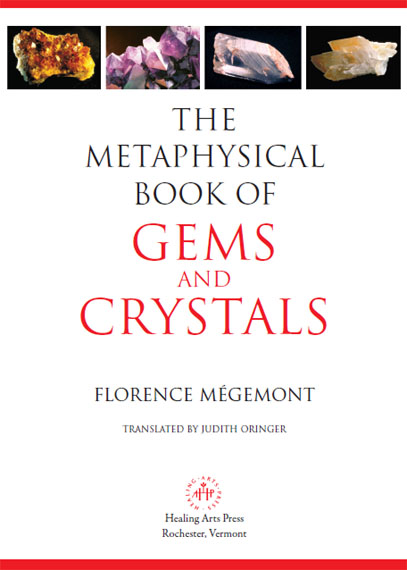
INTRODUCTION
THE THERAPEUTIC USE OF GEMS AND CRYSTALS
Stones have been used for therapeutic purposes since the beginning of time. Sorcerers and magicians, the magical men of the earliest communities, communed with the mineral world and used stones to heal a variety of illnesses. It was believed that stones came from heaven and remained alive after their fall.
Some believed they contained a particle of the divine breath, while others imagined that an animal, snake, or toad lived inside even the smallest pebble. It was also believed that each stone retained the heat it received from the sun.
In ancient China, the Manchurians considered stones to be the trees sister. To them, stones represented static energy as opposed to the cycle of vegetal growth. Stones, the unchanging principle of integral life, were thus able to restore all human faculties.
This permanent symbol of life also represented the triumph of life over death. Stones still mark the final resting place of our loved oneswe go to the stone to celebrate and remember the life of the person. There is also the widespread custom of throwing or placing stones on a tomb, or of burying the deceased with one or several precious stones. The tombs of the poor were often topped with only a simple stone engraved with a magical sign. In contrast, the royal tombs in Egypt were studded with precious jade and lapis lazuli. The ancients knowledge of the power of minerals suggests that the use of these stones ran much deeper than mere aesthetics.
THE ANCESTORS OF LITHOTHERAPY
In Asia, jade and jasper, are revered as noble stones. In the past, the medicinal use of these stones was subject to strict laws and breaking a jade object was immediately punished with death.
Jade, believed to be charged with yang energy, was accorded solar qualities. It was believed to be a panacea, the remedy for all diseases. According to the Chinese alchemist Ko-hung, it was thought that gold and jade, placed in the nine openings of the deceased, would keep the cadaver from putrefying. Placing pearls, said to contain yin energy, in the burial place ensured rebirth and reincarnation.
Witch doctors gave certain stones to sick people who rubbed them over the affected part of their bodies. The stone was believed to absorb the disease. Afterward, no one was allowed to touch the stone, since it was thought they could contract the disease contained in the mineral.
During the medieval period, building stones also served as medicine: the powder obtained by scratching the walls of a church was known to cure many illnesses.
Some stones were also used to concoct poisons. During the Renaissance, the Borgias used poison to eliminate their powerful rivals. This led to a curious confusion: it was thought that this murderous familys favorite poison contained nail clippings. In reality, Borgias poison contained onyx powder (onyx means nail in Greek), which, when accompanied by the powder of other minerals, can become toxic.
The importance of the black stone in Mecca illustrates the importance of minerals in that civilization. This fifty-foot stone stands in the center court of the Great Mosque. Forgiveness of sin is guaranteed to all who touch it.
Precious stones, from north Africa to Arabia, were charged with precise symbolism and believed to create magical powers. Wearing turquoise ensured victory, while carnelian and amber offered protection from the evil eye. The translucent stones were thought to be especially powerful. They were believed to contain the power of water in crystallized form, and this concentrated force was often used for magical and divinatory purposes. Wise men and fortune-tellers all made use of these stones.
In Greece and Rome, stones were used for counting. Small stones were worth one unit; others, five or ten unitsas with the Chinese abacus. This made it possible to make a list of the herds, evaluate merchandise, and inventory goods. In Latin, a pebble was called calculus or scrupulus. The word calculate has stayed with us and is still used in a mathematical context. These commercial practices led to speculation about the symbolic meanings of numbers. Stones were used in this debate, which eventually led to the esoteric practice of numerology.
The ancient Mexicans made hatchets and knives out of polished stone. These instruments of death, serving in human sacrifices, also represented rebirth, the cycle of the seasonseven eternity. These sacred tools were often made out of jade or obsidian, two stones that have great symbolic meaning.
In the Celtic tradition, stones were associated with fertility. Women in Brittany would scratch the tablets of the dolmensmegalithic monuments consisting of a large, flat stone laid horizontally across upright stonesand rub their bellies with the stone powder to become fertile. Granite, with its slight radioactivity, is conducive to pregnancy.
STONES AND RELIGIOUS TRADITIONS
In the Judeo-Christian tradition stones symbolized wisdom and permanence. They quenched the mystical thirst, just as water satisfies the bodys thirst. Traces of this symbolism can be found in the story of Moses who, when entering and leaving the desert, strikes a stone with his stick to create a stream of water. The philosophers stone, referring to the gospels, was also called the Lords bread. The angular stone has many, apparently contradictory, esoteric meanings.
Stones that are nurturing are another biblical theme: the devil tempts Christ by asking him to change stones into bread. Christ changed the name of a fisherman, calling him Peter (Pierre in French, which means stone) and on this stone founded the Church. Man, who is perishable and mortal, would become the first stone of a mystical edifice that has survived for two thousand years.
Precious stones in the Judeo-Christian tradition also represent transmutation, the sister of transfiguration. We move from the opaque to the transparent in the course of our evolutionary journey.
The German mystic Hildegard of Bingen wrote one of the first treatises on mineralogy that included the therapeutic qualities of each mineral. During the building of the great cathedrals in Europe, an extremely rich symbolism of the stones was developed. It was the era of the stone masters, the original freemasons. These builders were said to have passed along esoteric secrets to the less educated laborers as they traveled from site to site.
The city walls of the new Jerusalem were built in jasper and enhanced with various stones. The first stratum was jasper; the second, sapphire; the third, chalcedony; the fourth, emerald; the fifth, sardonyx; the sixth, carnelian; the seventh, chrysolite; the eighth, beryl; the ninth, topaz; the tenth, chrysoprase; the eleventh, hyacinth; the twelfth, amethyst. The twelve gates of the city were said to be twelve delicate pearls. It was not just a question of beauty or munificence; the symbolism of each stone was believed to be beneficial to the city.
THE BASIC VIBRATORY PATTERN
The intuitions of the ancients regarding stones are confirmed by modern science. The basic vibratory pattern, which controls the color and sound spectrum (the same word, chromatic, is used in both cases), is found in all physical phenomena, from electromagnetic waves to ripples in the water, or the infinite movement of electrons.
The apparent inertia of the smallest pebble shouldnt fool us; each pebble is both a transmitter and a receiver of various vibrations. Each stone vibrates and emits its own unique radiance. This radiance interacts with the electromagnetic field of our bodies in ways that still remain mysterious.
The great assemblage of megaliths at Carnac (in Brittany, France) and Stonehenge (England), and the obelisks and pyramids of Egypt and of pre-Columbian America, can all be thought of as wave receivers. These monuments captured cosmic energy and redistributed it to the ground. The stones, believed to be connected to the planets, had not yet revealed all their secrets to the ancients, but people did note strange phenomena associated with them. In fact, we only know a little bit more about them today; the stones still have many secrets to reveal.
Next page

